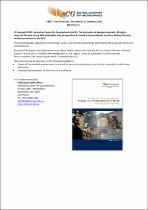JavaScript is disabled for your browser. Some features of this site may not work without it.
- ResearchSpace
- →
- Research Publications/Outputs
- →
- Conference Publications
- →
- View Item
| dc.contributor.author |
Vogt, D

|
|
| dc.date.accessioned | 2012-01-13T13:30:25Z | |
| dc.date.available | 2012-01-13T13:30:25Z | |
| dc.date.issued | 2011-11 | |
| dc.identifier.citation | Vogt, D. 2011. A renaissance for mining research in South Africa?. 4th International Seminar on Strategic versus Tactical Approaches in Mining, Perth, Australia, 8-10 November 2011 | en_US |
| dc.identifier.uri | http://hdl.handle.net/10204/5485 | |
| dc.description | Copyright: 2011 Australian Centre for Geomechanics | en_US |
| dc.description.abstract | Mining research in South Africa dates back to the early days of the Witwatersrand gold fields: research into seismicity celebrated its centenary in South Africa in 2010, and advances in the understanding of seismicity and rock mechanics allowed the gold mines to continue operating during the 1960s. With few exceptions, research in South Africa was driven by the industry, and was largely undertaken at the industry's own research facility, the Chamber of Mines Research Organisation, or COMRO. In the early 1990's, several factors combined to lead the industry to abandon COMRO: the low gold price; the establishment of a safety levy to fund the newly created statutory Safety in Mines Research Advisory Committee; and the emergence of South Africa from isolation which allowed mining companies to invest in lower cost deposits in other countries. A period of decline in mining research followed. After twenty years of neglect, the industry and government are recognizing the role that research played in the past, and are acknowledging the need for continued impact to ensure that future mines are able to access new technology. They are also recognizing the role played by the highly skilled individuals produced in research environments. The CSIR is working with key stakeholders to form the nucleus of a revived research capability in the country through the establishment of a Centre of Excellence for safety and health; and through its internal mining Research Impact Area. Anglogold Ashanti and its Technology Innovation Consortium are also increasing interest in research. The signs are promising that South Africa is starting to support its researchers again in the way that other major mining countries have over the last decade. | en_US |
| dc.language.iso | en | en_US |
| dc.publisher | Australian Centre for Geomechanics | en_US |
| dc.relation.ispartofseries | Workflow request;7071 | |
| dc.subject | South African mining | en_US |
| dc.subject | Mining research | en_US |
| dc.subject | Seismicity | en_US |
| dc.subject | South African mining research | en_US |
| dc.subject | Mining | en_US |
| dc.title | A renaissance for mining research in South Africa? | en_US |
| dc.type | Conference Presentation | en_US |
| dc.identifier.apacitation | Vogt, D. (2011). A renaissance for mining research in South Africa?. Australian Centre for Geomechanics. http://hdl.handle.net/10204/5485 | en_ZA |
| dc.identifier.chicagocitation | Vogt, D. "A renaissance for mining research in South Africa?." (2011): http://hdl.handle.net/10204/5485 | en_ZA |
| dc.identifier.vancouvercitation | Vogt D, A renaissance for mining research in South Africa?; Australian Centre for Geomechanics; 2011. http://hdl.handle.net/10204/5485 . | en_ZA |
| dc.identifier.ris | TY - Conference Presentation AU - Vogt, D AB - Mining research in South Africa dates back to the early days of the Witwatersrand gold fields: research into seismicity celebrated its centenary in South Africa in 2010, and advances in the understanding of seismicity and rock mechanics allowed the gold mines to continue operating during the 1960s. With few exceptions, research in South Africa was driven by the industry, and was largely undertaken at the industry's own research facility, the Chamber of Mines Research Organisation, or COMRO. In the early 1990's, several factors combined to lead the industry to abandon COMRO: the low gold price; the establishment of a safety levy to fund the newly created statutory Safety in Mines Research Advisory Committee; and the emergence of South Africa from isolation which allowed mining companies to invest in lower cost deposits in other countries. A period of decline in mining research followed. After twenty years of neglect, the industry and government are recognizing the role that research played in the past, and are acknowledging the need for continued impact to ensure that future mines are able to access new technology. They are also recognizing the role played by the highly skilled individuals produced in research environments. The CSIR is working with key stakeholders to form the nucleus of a revived research capability in the country through the establishment of a Centre of Excellence for safety and health; and through its internal mining Research Impact Area. Anglogold Ashanti and its Technology Innovation Consortium are also increasing interest in research. The signs are promising that South Africa is starting to support its researchers again in the way that other major mining countries have over the last decade. DA - 2011-11 DB - ResearchSpace DP - CSIR KW - South African mining KW - Mining research KW - Seismicity KW - South African mining research KW - Mining LK - https://researchspace.csir.co.za PY - 2011 T1 - A renaissance for mining research in South Africa? TI - A renaissance for mining research in South Africa? UR - http://hdl.handle.net/10204/5485 ER - | en_ZA |






